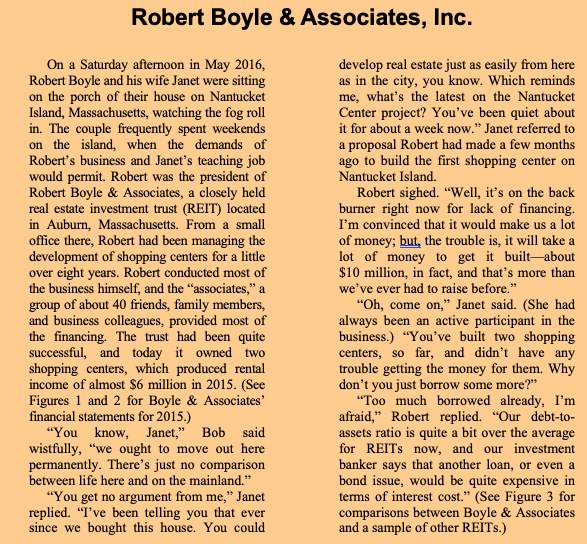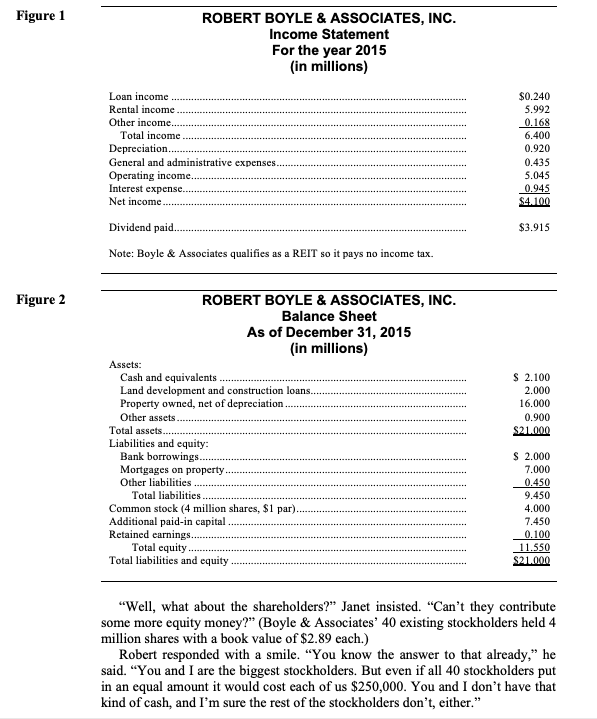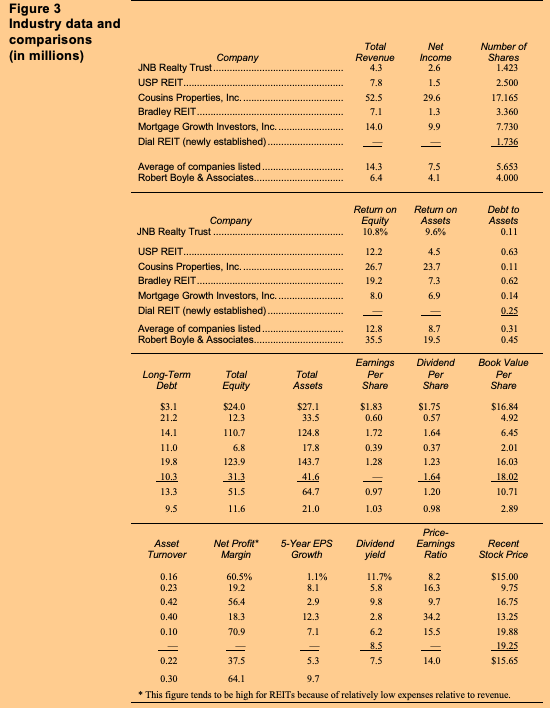Please help
Robert Boyle & Associates, Inc. On a Saturday afternoon in May 2016, develop real estate just as easily from here Robert Boyle and his wife Janet were sitting as in the city, you know. Which reminds on the porch of their house on Nantucket Island, Massachusetts, watching the fog roll me, what's the latest on the Nantucket Center project? You've been quiet about in. The couple frequently spent weekends it for about a week now." Janet referred to on the island, when the demands of Robert's business and Janet's teaching job a proposal Robert had made a few months ago to build the first shopping center on would permit. Robert was the president of Nantucket Island. Robert Boyle & Associates, a closely held Robert sighed. "Well, it's on the back real estate investment trust (REIT) located burner right now for lack of financing. in Auburn, Massachusetts. From a small I'm convinced that it would make us a lot office there, Robert had been managing the of money; but, the trouble is, it will take a development of shopping centers for a little lot of money to get it built-about over eight years. Robert conducted most of $10 million, in fact, and that's more than the business himself, and the "associates," a we've ever had to raise before." group of about 40 friends, family members, "Oh, come on," Janet said. (She had and business colleagues, provided most of always been an active participant in the the financing. The trust had been quite business.) "You've built two shopping successful, and today it owned two centers, so far, and didn't have any shopping centers, which produced rental trouble getting the money for them. Why income of almost $6 million in 2015. (See don't you just borrow some more?" Figures 1 and 2 for Boyle & Associates' "Too much borrowed already, I'm financial statements for 2015.) afraid," Robert replied. "Our debt-to- "You know, Janet," Bob said assets ratio is quite a bit over the average wistfully, "we ought to move out here for REITs now, and our investment permanently. There's just no comparison banker says that another loan, or even a between life here and on the mainland." bond issue, would be quite expensive in "You get no argument from me," Janet terms of interest cost." (See Figure 3 for replied. "I've been telling you that ever comparisons between Boyle & Associates since we bought this house. You could and a sample of other REITs.)Figure 1 ROBERT BOYLE & ASSOCIATES, INC. Income Statement For the year 2015 (in millions) Loan income .... $0.240 Rental income .. 5.992 Other income. 0.168 Total income .. 6.400 Depreciation......... 0.920 General and administrative expenses...... 0.435 Operating income...... 5.045 Interest expense.... 0.945 Net income.... $4.100 Dividend paid..... $3.915 Note: Boyle & Associates qualifies as a REIT so it pays no income tax. Figure 2 ROBERT BOYLE & ASSOCIATES, INC. Balance Sheet As of December 31, 2015 (in millions) Assets: Cash and equivalents .................-.....:- $ 2.100 Land development and construction loans....... 2.000 Property owned, net of depreciation.... 16.000 Other assets ...... 0.900 Total assets...... $21.000 Liabilities and equity: Bank borrowings.. $ 2.000 Mortgages on property. 7.000 Other liabilities .. 0.450 Total liabilities ..........=- 9.450 Common stock (4 million shares, $1 par). 4.000 Additional paid-in capital . 7.450 Retained earnings..... 0.100 Total equity ........ 11.550 Total liabilities and equity .... $21.000 "Well, what about the shareholders?" Janet insisted. "Can't they contribute some more equity money?" (Boyle & Associates' 40 existing stockholders held 4 million shares with a book value of $2.89 each.) Robert responded with a smile. "You know the answer to that already," he said. "You and I are the biggest stockholders. But even if all 40 stockholders put in an equal amount it would cost each of us $250,000. You and I don't have that kind of cash, and I'm sure the rest of the stockholders don't, either.""Well, then," Janet continued unperturbed, "you need some more stockholders. Why don't you sell stock to the public? I'm sure it would be a great success once people knew what the company's plans were." "Yes, that's what our investment banker said, too," Robert replied. "But I have some reservations. For instance, look at the dilution effect. You know, to qualify as a REIT, and, therefore, to pay no income tax at the corporate level, we pay out 95 percent of earnings every year as dividends. Anything that affects earnings per share, then, affects the shareholders' dividends. If we issue a whole lot of new stock, earnings per share will be diluted severely, and the existing stockholders will be most unhappy!" "But, Robert," Janet said, "aren't you ignoring the money you will make on the proceeds of the stock issue? It seems to me that the income from the investment ought to more than offset the initial dilution, producing even more earnings-and dividends-than before. Surely the stockholders will see that." "Maybe so," Robert said, "but that's not the only problem. Suppose, for example, that the whole shopping center deal falls through?" (It was not certain at this time that the residents and government authorities on Nantucket would approve the project.) "If it does, the price of our company's shares, now publicly traded, will surely fall, to the dismay and embarrassment of us all. You know, managing a publicly traded company is not at all like managing a private one. The pressure for short-term performance is terrific. If I don't produce, I'll be voted out of office at the next shareholders' meeting." "And that's another thing," Robert continued, warming up, "shareholders' meetings. Look what you have to go through as a publicly traded company: shareholders' meetings, annual reports, SEC filings, disclosure notices, regulators poking around; why, the administrative tasks alone will require a couple of full-time people! Besides that, look at the cost of the issue itself. The investment banker will take a cut of about 6.5 percent of the issue, and we'll have to pay about $60,000 out- of-pocket for legal and accounting fees and printing expenses. I bet we'd have to issue almost $11 million in stock just to get $10 million in cash. Pretty expensive!" "Yes, that's so," Janet agreed. "But even so, the benefits might outweigh the costs. One thing you haven't mentioned is the increase in liquidity for the company's shares you would get if they were publicly traded. You know most of our existing shareholders have been with us for the whole eight years, and they have quite a bit of money tied up in this one basket. How can they diversify their portfolios or sell their holdings outright? I bet they'd love to see the shares publicly traded in the market with an established price." "All right, you may have a point," Robert conceded. "Tell you what, I'll write a letter to our existing stockholders outlining the pros and cons, and ask them to respond with recommendations. If the prevailing sentiment is to go public, we'll do it, and if it's not, we won't. In the end, though, the whole discussion may depend on how badly we want to build the Nantucket Center. If we want it, we'll probably have to go public to build it." "I knew you would have it all figured out," Janet said, approvingly. "Now, how about a martini?"Figure 3 Industry data and comparisons (in millions) Total Net Number of JNB Realty Trust. Company Revenue Income Shares 4.3 2.6 1.423 USP REIT.. 7.8 1.5 2.500 Cousins Properties, Inc. 52.5 29.6 17.165 Bradley REIT..... 7.1 1.3 3.360 Mortgage Growth Investors, Inc.. 14.0 7.730 Dial REIT (newly established) .. 1.736 Average of companies listed. 14.3 7.3 5.653 Robert Boyle & Associates.. 6.4 4.1 4.000 Return on Return on Debt to Company Equity Assets Assets JNB Realty Trust .. 10.8% 9.6% 0.11 USP REIT.. 12.2 4.5 0.63 Cousins Properties, Inc. 26.7 23.7 0.11 Bradley REIT. 19.2 7.3 D.62 Mortgage Growth Investors, Inc. .. 8.0 6.9 D.14 Dial REIT (newly established) . 0.25 Average of companies listed . 12.8 8.7 0.31 Robert Boyle & Associates.. 35.5 19.5 1.45 Earnings Dividend Book Value Long-Term Total Total Per Per Per Equity Assets Share Share Share I'ES $24.0 $27. $1.83 $1.75 $16.84 21.2 123 33.5 0.60 0.57 4.92 14.1 110.7 124.8 1.72 1.64 6.45 11.0 6.8 17.8 0.39 0.37 2.01 19.8 123.9 143.7 1.28 1.23 16.0 10.3 31.3 41.6 1.64 18.02 13.3 51.5 64.7 0.97 1.20 10.71 9.5 11.6 21.0 1.03 0.98 2.89 Price- Asset Net Profit" 5-Year EPS Dividend Earnings Recent Turnover Margin Growth Ratio Stock Price 0.16 60.5% 1.1% 11.7% 8.2 $15.00 0.23 19.2 5.8 16.3 9.75 0.42 56.4 2.9 9.7 16.75 0.40 183 12.3 2.8 34.2 13.25 D.10 7.1 6.2 15.5 19.88 8.5 19.25 0.27 37.5 5.3 7.5 14.0 $15.65 0.30 64.1 9.7 * This figure tends to be high for REITs because of relatively low expenses relative to revenue.Required 1. Refer to Figure 3 for comparisons between Boyle & Associates and other REITs. Note the industry average price-earnings ratio. The investment banker will set Boyle's P/E ratio based on how the company compares to the industry average in six areas: return on equity, return on assets, debt to assets, asset turnover, net profit margin, and five-year earnings per share growth. The investment banker will start with the industry average P/E, and will add one-half point for each of the areas in which Boyle is superior to the industry, and will subtract one-half point for each area in which Boyle is inferior to the industry. After tabulating the results, the investment banker will subtract one point for good measure to ensure the issue presents an attractive opportunity. On this basis, what will the banker determine to be the proper P/E ratio for Boyle & Associates? 2. Considering that the banker's spread will be 6.5 percent of the total issue size, and Boyle will have to pay $60,000 out-of-pocket expenses, what is the total issue size necessary to yield $10 million in cash to the company? Use the formula: X - .065X - $60,000 = $10,000,000. X is the issue size. Round your answer upward to the nearest $100,000. 3. Assume 699,029 shares will be sold at a public price of $15.45 to provide approximately $10.8 million. What dollar return on the net proceeds of the offering must Boyle & Associates earn to bring earnings per share up to what it was before the offering? ($1.03) After you compute the dollar return on the net proceeds, convert this to a ratio (percentage of net proceeds). Compare this answer to Boyle's return on assets in 2015 (Figure 3). Based on the company's performance in 2015, do you think the required return can be earned? 4. If half of Boyle's associates decide to sell their existing shares in addition to the initial offering, how many total shares will have to be issued by the company to yield $10 million in cash to the company? 5. Summarize the pros and cons of Boyle & Associates going public from the information in the case and your reading of the text, Chapter 15. If you were one of the existing stockholders and you received Robert Boyle's letter, would you recommend going public or not? What would be the major reason affecting your opinion











